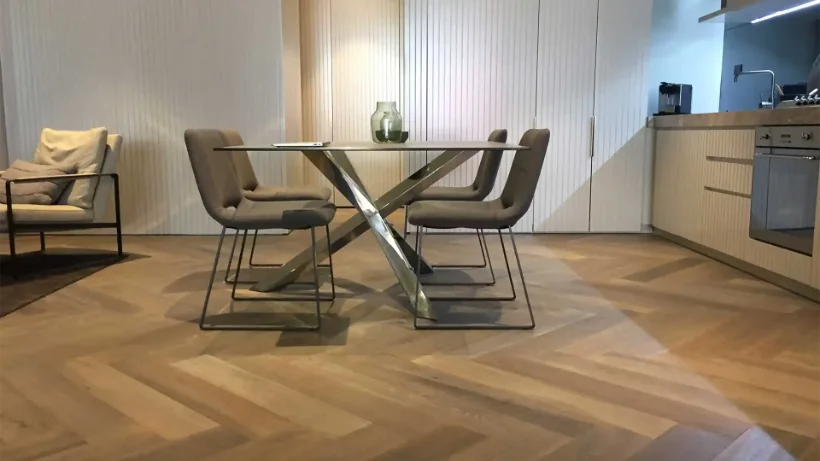
Australian homeowners considering an aesthetic and functional upgrade will benefit from a herringbone wood floor kitchen, This timeless design has existed for centuries and has been an interior design fixture in numerous living spaces nationwide. Its distinct, eye-catching zigzag patterns make indoor quarters elegant, expansive, and functional. Your kitchen will also reap these benefits with the help of a trusted, highly experienced Brisbane hybrid flooring company.
Are you considering herringbone floor tiles in kitchen? This blog will explain how this enduring floor alternative can transform your culinary space and its possible drawbacks, empowering you to make enlightened, long-term buying decisions.
What Is Herringbone Flooring?
Herringbone wood flooring is a decorative indoor floor with rectangular planks or blocks in a staggered zigzag pattern, creating a right angle and a broken “V” shape. This parquet style dates back to ancient Rome and has enhanced the aesthetics, depth, dimension, and texture of indoor living spaces for centuries.
Herringbone floors’ ability to increase visual interest, curb appeal, and timeless elegance makes it a cost-effective choice for Australian kitchens. This flooring type seamlessly integrates with many interior designs, adding character and functionality to various culinary spaces.
This wood flooring doesn’t have a specific angular limit. Homeowners can expand beyond the traditional zigzag design and combine it with squares and planks to make their kitchens timeless, sophisticated, and unique.
There are many different styles of herringbone flooring but regardless of your preference, a trusted Sydney hybrid flooring company can help install a cost-effective, aesthetically pleasing, and functional herringbone floor to spruce up your culinary space.
Pros of Using Herringbone Flooring for the Kitchen
Installing herringbone wooden flooring can be a game-changer for your kitchen. This timeless design increases visual appeal and functionality, making it an excellent choice for Australian homeowners prioritising practicality and sophistication.
Culinary spaces are among the busiest areas at home. Whether enjoying a hearty meal with family or guests, they will appreciate a herringbone floor’s timeless elegance. This resilient floor design’s ability to withstand high foot traffic makes it a practical and stylish choice for busy Australian kitchens.
The advantages of herringbone floors for kitchens include the following:
1) Visual Appeal
Many homeowners love the herringbone pattern because of its distinct, beautiful design that transforms dull, drab culinary spaces into visually stunning kitchens. Regardless of your theme, herringbone floors mesh seamlessly with rustic to contemporary themes and various colours that liven up your house’s busiest area.
This floor pattern isn’t merely about aesthetics; designers love its ability to add depth and texture to different kitchen settings. Whether you prefer wood, stone, or tiles for your kitchen, herringbone floors complement them perfectly and provide timeless elegance.
Herringbone wooden flooring can also expand kitchen spaces and make them feel larger, enhancing the ambience. Families residing in cramped, dense quarters will enjoy this long-term benefit.
2) Resilience
Herringbone flooring’s resiliency and ability to withstand constant, high-foot traffic make it an excellent choice for busy kitchens. Vinyl herringbone and LVT flooring alternatives can resist moisture and scratches, compromising inferior-quality versions. You can relax knowing that herringbone flooring stands the test of time and retains its durability in demanding kitchens.
Industry experts attribute its remarkable resilience to premium materials, such as vinyl herringbone, which can endure daily wear and tear. On the other hand, luxury vinyl tiles’ (LVT) multilayered construction guarantees long-term durability and peace of mind.
3) Low maintenance
Herringbone maintenance is straightforward. Choosing time-tested, robust, waterproof vinyl facilitates the process. As Australia’s trusted hybrid flooring experts, we strongly recommend sweeping two to three times weekly and mopping once a week to achieve optimum results. It’s important to remember that kitchens are prone to spills and messes, so regular maintenance is imperative.
Avoid using harsh chemicals, steam mops, and excess water because they may damage the flooring.
4) Adaptability
Herringbone kitchen flooring’s versatility seamlessly meshes with various aesthetics, including traditional and contemporary settings. Whether using engineered wood or oak, herringbone easily adapts to different culinary surroundings and functionalities, making it an easy choice for your busy kitchen.
Several herringbone styles popular among Aussie homeowners include the following:
- Engineered timber: We recommend this durable material for high-moisture settings. Engineered wood provides homeowners with stylish, resilient flooring that endures over time.
- Premium vinyl: This herringbone floor style mimics natural wood, providing homeowners with a cost-effective, natural aesthetic that adds a unique rustic touch to busy culinary spaces.
Each version makes Australian kitchens more visually appealing and functional. Whether you choose engineered wood, oak, or luxury vinyl flooring, you will enjoy an elegant kitchen upgrade that provides excellent value for money.
Cons of Using Herringbone Flooring for the Kitchen
Although herringbone flooring offers homeowners numerous advantages, we strongly urge them to consider possible drawbacks so they can make sound home-buying decisions that align with their budget, lifestyle, and aesthetics.
The disadvantages of herringbone flooring include the following:
1) Price
Herringbone floors can be costly due to labour-intensive installation and premium materials. Solid hardwood or premium engineered wood flooring is more expensive than vinyl or laminate herringbone.
Consult a trusted service provider who can recommend the best budget-friendly herringbone flooring type for your kitchen.
2) Laborious assembly
Installing herringbone kitchen flooring can be laborious and time-consuming because of the required precision in laying out the design. Highly experienced builders may take two to four days to complete the installation, and they may require an additional day or two for subfloor repairs or sealing.
3) Can scratch easily
Herringbone kitchen floors made from solid hardwood, engineered wood, and laminate flooring are susceptible to scratches and dents. Using these versions for high-foot-traffic culinary spaces may backfire and affect their appearance over time.
We strongly recommend choosing resilient herringbone versions that endure over time, including luxury vinyl plank (LVP) and hybrid flooring (SPC or WPC core). These low-maintenance, robust alternatives can withstand high foot traffic, moisture, scratches, and dents, providing your kitchen with an elegant, functional decorative indoor floor.
Our Most Popular Herringbone Hybrid Flooring Styles
Be sure to view the most popular herringbone hybrid flooring styles among our customers:
- Natural Oak Herringbone Hybrid Flooring
- Blackbutt Herringbone Hybrid Flooring
- Hamptons White Herringbone Hybrid Flooring
Conclusion
Herringbone kitchen flooring adds timeless elegance and functionality to Australian kitchens. Whether you prefer a rustic or contemporary design, this decorative floor is a game-changer for your house’s busiest indoor area.
It’s crucial to remember that herringbone floors have disadvantages. We strongly recommend weighing their pros and cons with your unique preference to make an informed long-term decision.
If you need help with herringbone flooring for your culinary space, we’re here to help. Contact us today to schedule an appointment, receive an upfront, personalised quotation, and arrange an on-site inspection. Our staff can install the ideal herringbone floor for your kitchen to create an elegant and enduring interior space.





